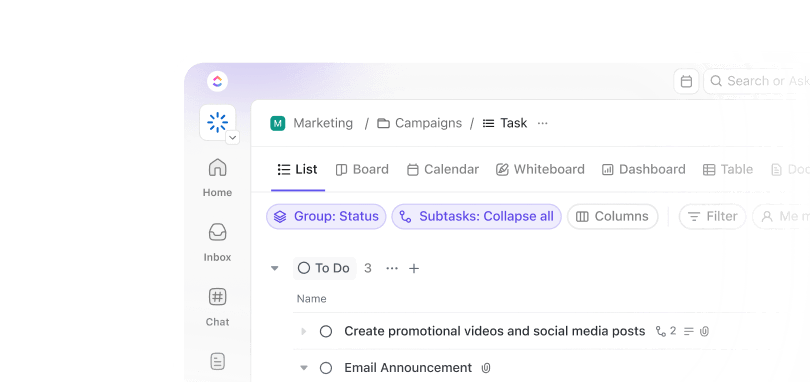Ever wonder what your competitors are doing behind the scenes to stay ahead? A good 74% of business leaders recognize the importance of improved market intelligence, but many still find it challenging to stay ahead.
Learning how to do a competitor analysis can be your answer. It gives you the inside scoop, revealing your competitors’ advantages, disadvantages, and strategies—a key to unlocking your own business growth!
It may not have the thrill of an old-school espionage thriller, but it can be equally enlightening and help you spot market gaps.
In this guide, we’ll walk you through the steps to effectively conduct competitor analysis and leverage that knowledge to strengthen your business strategy. Ready to see what your competitors are up to? Let’s go!
How to Conduct a Competitor Analysis (+Template)
⏰ 60-Second Summary
To conduct your own competitive analysis:
- Identify your top rivals—direct and indirect competitors
- Gather data on their products, services, pricing, and marketing strategies
- Track their online performance using tools like Google Analytics or Dashboards
- Analyze customer reviews and market share
- Evaluate their strengths, weaknesses, opportunities, and threats (SWOT)
- Look into consumer behavior and feedback to understand competitor perception
- Find market gaps and optimize your own business strategy based on insights
- Choose a tool like that improves the process of competitive analysis with stand-out features and templates
What Is a Competitive Analysis?
Competitive analysis is the process of evaluating your competitors to understand their strengths, weaknesses, and market positioning.
It’s all about taking a deeper look at how your competitors have been working and their playbook for marketing and selling. These insights can help you improve your own offering better.
For example, when Netflix entered the streaming space, it clearly understood what its competitor, Blockbuster, was doing—and, more importantly, what it wasn’t.
Netflix aimed to fill the gaps by offering subscription-based pricing, convenience through mail delivery (and later streaming), and a focus on customer experience. By addressing these pain points, Netflix quickly gained traction and transformed the entertainment industry.
Competitive analysis is your strategy cheat sheet that helps you:
- Get a clear view of the competitive landscape
- Take a fresh look at your own strengths, weaknesses, opportunities, and threats (hello, SWOT analysis!)
- Figure out the best way to position your product
It’s a key piece of your broader competitive intelligence strategy.
👀 Did You Know? Coca-Cola and Pepsi have analyzed each other’s moves for over a century. In the 1970s, Pepsi famously conducted the ‘Pepsi Challenge,’ a blind taste test to highlight their product’s sweetness. Coca-Cola responded by launching ‘New Coke in 1985—only to revert to its original formula after public outcry. This rivalry shows how competitive analysis can spark bold moves (and sometimes big lessons)!
How to Conduct a Competitive Analysis
Thanks to an array of software and the development of AI tools, conducting a competitive analysis has never been more straightforward.
One standout option is , an everything app for work that helps you organize all your research and insights in one place. With features like Task Tracking, Customizable Dashboards, and document sharing, ensures you make the most of your competitive analysis.
Now, let’s understand how to conduct a competitive analysis that sets you up for victory!
Step 1: Identify competitors
The first step to conducting a competitor analysis is identifying your competition and gathering essential details about your business.
Here’s what you need to consider:
- Direct competitors: Businesses offering similar products or services to the same target audience. They compete for the same market share and customer base
- Indirect competitors: Companies offering alternatives that might fulfill the same customer needs, even if they aren’t the same product or service
- Emerging competitors: New players entering the market with innovative solutions that could disrupt the industry
- Market positioning: Understand where competitors stand in the market—who is leading and who is lagging behind
Once identified, you can investigate their strategies, pricing, marketing tactics, and customer engagement to better position your own business for success. To keep them all in one place, consider using Docs.
Docs

With Docs, you can create dynamic documents that organize your competitive insights. These documents can include nested pages, templates, and embedded tables.
When you find a competitor’s strength that you need to deploy, tag your team in the comments and assign tasks to them. This way, you can turn your idea into an actionable step! Plus, you can link Docs to tasks, track updates, and manage projects directly within your documents. The Docs Hub lets you sort, search, and access verified wikis and templates with ease.
You can also manage permissions and securely share Docs with your team, guests, or even the public.
Step 2: Conduct market research
Once you’ve identified your direct competitors, it’s time to start your market research. This step helps you understand the broader industry landscape and your competitors’ standing in it.
Start by gathering data on industry trends, market size, and growth. Look at demographic information through primary research (surveys, interviews, focus groups) and secondary research (industry reports, competitor analysis, academic studies) to collect valuable insights
Additionally, assess both points of parity (shared traits with competitors) and points of differentiation (what sets you apart).
Forms
One way to collect information and keep all your data centralized in one place is to use Forms. It’s perfect for designing and sharing surveys and feedback from your target audience, making the process simple and efficient.


Here’s all that you can do with Forms:
- Convert survey responses into tasks that integrate easily with your workflows, getting projects moving faster
- Use conditional logic to capture only the most relevant data, making the intake process simple
- Customize Forms for any need, from product feedback to sales lead routing, ensuring you collect the right insights
- Turn feedback into actionable tasks and assign them automatically to the right team members, speeding up product improvements
👀 You Know? A study by Hanover Research found that 91% of businesses reported an increase in sales after using market research data.
Step 3: Analyze competitor capabilities and market position
Understanding your competitors’ strengths and market standing is a crucial step in creating your own go-to-market strategy.
This step involves evaluating their operational efficiency, product offerings, marketing efforts, and overall market position.
Explore metrics like market share, pricing strategies, and customer reach to identify what they excel at and where they fall short. Focus on areas such as product quality, brand reputation, and innovation to gauge their competitive edge.
Dashboards
Wouldn’t it be great to visualize all this data in one place? Dashboards help you quickly transform complex insights into actionable visuals.


With , you can create a winning competitor dashboard by:
- Customizing widgets: Add charts, tables, and custom widgets to track key metrics like market share, competitor pricing, and campaign performance—all in real-time
- Visualizing trends: Use line or bar graphs to compare competitors’ growth rates and monitor industry trends, making data-driven decisions with ease
- Tracking performance: Keep an eye on KPIs such as competitor engagement rates or product launches with metrics widgets tailored to your strategy
- Integrating data sources: Bring data from multiple tools into one unified view, giving you a comprehensive snapshot of your competitive landscape
- Collaborating in real-time: Share dashboards with your team, update insights collaboratively, and assign action items directly from the dashboard
Step 4: Compare marketing efforts
Want to outpace your competitors?
Get a feel of their marketing strategies—a key part of competitive analysis. Understand their social media presence, SEO performance, digital ad campaigns, and content marketing efforts.
Identify what resonates with their audience and where they fall short. This comparison helps optimize your social media audits and refine your marketing planning process to engage your target market effectively.
Custom Fields
With , you can create Custom Fields on your competitor dashboard to track crucial metrics like social engagement, keyword rankings, and content strategy.


You can tailor these fields to monitor competitors’ activities or evaluate your own strategy. For example, create Custom Fields to track metrics like Social Media Engagement, SEO Keyword Rankings, or Ad Spend Performance.
Step 5: Evaluate consumer behavior and customer experience
According to Forbes, 53% of consumers say a company’s experience is just as necessary as its products or services. This highlights the need to analyze customer reviews and feedback thoroughly.
Start by gathering data on purchasing habits, browsing behavior, and feedback through surveys, social media, and analytics tools. Look at factors like how often customers buy, what influences their decisions, and their level of engagement with your marketing campaigns.
Analyzing customer experience involves assessing how easy it is for customers to navigate your website, make purchases, and interact with your support team.
Doing so lets you understand where competitors shine or stumble and use these insights to elevate your customer experience.
Step 6: Use Perceptual Mapping and Profit Analysis
Want to see where you stand in the market? Perceptual mapping is a visual tool that compares your brand to key competitors based on crucial attributes like price, quality, and service.
Another valuable method is profit analysis, which involves analyzing financial data—such as pricing, costs, and market share—to assess profitability and identify areas for improvement.
Here’s how you can use these tools effectively:
For Perceptual Mapping:
- Choose two relevant attributes for your market, like price vs. quality
- Plot your brand and competitors on a simple 2D graph based on customer perceptions
- Identify gaps in the market, highlighting areas where you can stand out or improve
For Profit Analysis:
- Review public financial reports, such as pricing models and cost structures
- Compare your sales data and market share to competitors to spot trends
- Use this information to adjust pricing strategies, cut unnecessary costs, or target more profitable segments
Perceptual mapping and profit analysis provide a clear view of your market position and where improvements can lead to greater profitability and market positioning.
💡 Pro Tip: Pair competitive analysis with gap analysis to spot where you’re lagging and focus on closing those gaps for a more decisive edge.
Step 7: Identify opportunities and threats
To stay ahead, you need to spot opportunities that propel you forward and threats that could trip you up. Opportunities might be hidden in new markets or untapped niches, while threats could lurk in competitor moves or industry shifts.
A fun way to stay on top is to conduct a SWOT analysis—a study of strengths, weaknesses, opportunities, and threats.
For example, in project management, you could discover an opportunity to boost efficiency with a new tool or a threat where a competitor is underpricing your services. With this insight, you can turn challenges into wins and keep your strategy sharp!
📮 Insight: 37% of workers send follow-up notes or meeting minutes to track action items, but 36% still rely on other, fragmented methods.
According to research by , without a unified system for capturing decisions, key insights you need may get buried in communication channels like chats, emails, or spreadsheets. With , you can instantly turn conversations, especially important ones about gaining a competitive advantage, into actionable tasks across all your tasks, chats, and docs—ensuring nothing falls through the cracks.
Competitive Analysis Examples
A well-executed competitive analysis gives companies the insights they need to make informed decisions and stay ahead of the game.
⭐ Let’s assume we’re a company called Brew Haven, conducting a competitive analysis to understand the local coffee shop market better and refine our business strategy. Our key competitors are Bean & Co. and Aroma Bliss.
🔎 Key Insights:
- Strengths: We offer convenience with the fastest service in town and a loyalty program that drives repeat visits. However, Bean & Co. excels in ambiance, catering to remote workers with free Wi-Fi, while Aroma Bliss offers specialty drinks.
- Weaknesses: Our competitors have a more substantial online presence. Bean & Co. engages customers through social media, and Aroma Bliss’s Instagram collaborations attract niche audiences. Meanwhile, our social media is underdeveloped.
- Opportunities: Implementing online ordering and expanding social media efforts can help us compete more effectively. Aroma Bliss’s success with specialty drinks highlights an opportunity to introduce unique menu items, like seasonal beverages.
🥇 Next Steps:
We must launch an online ordering system and improve our social media strategy. We must also explore partnerships with local vendors to enhance our offerings. These steps will strengthen our market position and attract new target customers while retaining our loyal base.
Common Mistakes to Avoid
Even the sharpest strategies can falter if common pitfalls trip you up. Here’s what to watch out for when diving into competitive analysis:
- Focusing only on direct competitors: Broaden your scope—disruptors can come from anywhere
- Using outdated data: Stay current; yesterday’s insights won’t win today’s game
- Ignoring internal benchmarks: Track your own progress alongside competitor metrics
- Tracking too many metrics: Focus on key indicators to avoid data overload
- Skipping actionable insights: Turn your analysis into clear, impactful actions
Avoid these pitfalls; you’ll transform your competitive analysis into a powerful growth engine.
Having the right tools can transform your competitive analysis from basic to brilliant. Different competitor analysis tools excel in specific areas, so it’s crucial to align your choice with your business goals and needs.
Let’s help you cut through the noise. Here are a few tools with the best competitive analysis templates you should consider using:
1.
stands out with reporting tools, over 1,000+ templates, and native integrations tailored to make the process stress-free.


You can use to:
- Set and track your business goals and KPIs using Goals
- Integrate your work on the platform with 80+ tools, including Google Drive, Google Analytics, and Slack
- Collaborate in just a few clicks through comments, chats, docs, and whiteboards in the Spaces
- Automate repetitive tasks to save time and enhance team productivity with Automations
- Use Brain, the AI-powered assistant, to create competitive analysis reports, brainstorm ideas, and create actionable plans quickly
As a bonus, you can start your competitive analysis immediately with the Competitive Analysis Template. This template makes competition analysis easy and engaging by building an Ansoff Matrix.
The interactive Whiteboard allows you to add, adjust, and arrange your insights cohesively. Each quadrant compares elements based on your chosen metrics, guided by a clear legend.
With this industry analysis template, you can uncover competitor strengths and weaknesses, understand the market landscape, and develop strategies to stay ahead—whether you’re launching a new product or expanding an existing one.
2. Google Analytics
Google Analytics offers valuable insights into your website traffic, revealing visitors’ demographics, location, and behavior patterns.
It also tracks user engagement, showing the pages they browse, how long they stay, and the actions they take—like completing a purchase or submitting a form. These insights empower you to enhance your website’s user experience and boost conversions effectively.
💡 Pro Tip: Integrate Google Analytics into an analytics template with to compare your website performance against competitors.
3. Crayon
Crayon offers a comprehensive suite of AI-powered tools for competitor analysis. It provides a detailed overview of competitor strategies and tracks everything from social media activity to website updates in real time.
Top features include insights into pricing, products, and market trends, helping businesses stay ahead of industry shifts. With integrations and real-time alerts, Crayon ensures you’re always in the loop on competitor activities.
Optimize Your Competitive Analysis With
Today, staying ahead means leveraging every tool at your disposal. Traditional competitor analysis methods can fall short of providing the agility and insights you need to thrive.
That’s where comes in.
With powerful features like Custom Dashboards, Collaborative Whiteboards, and optimized integrations, helps you analyze your competition, adapt to new markets, and act swiftly.
It’s not just about keeping up—it’s about leading the way. Ready to turn insights into impact?
Sign up for a account today!


Everything you need to stay organized and get work done.














